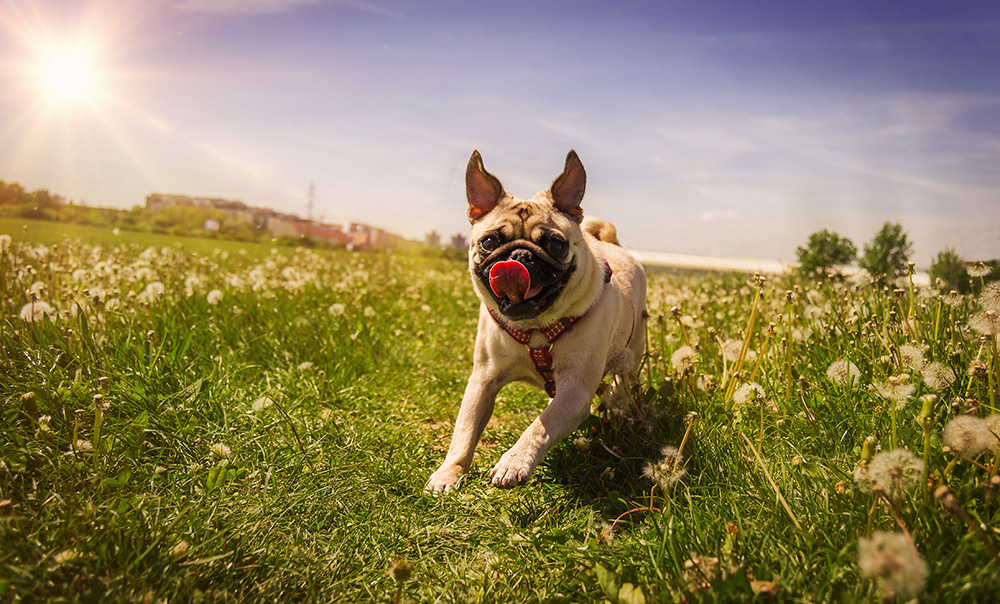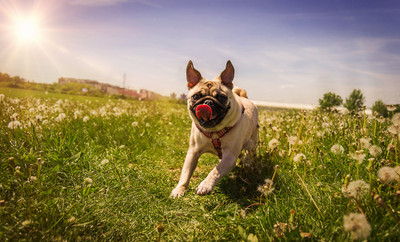Posted by Zena Conkey on May 30, 2020

Most of us look forward to the sunny days and warm weather that summer brings but it can cause our canine companions to struggle, especially when exercising. Heatstroke can be a serious risk for dogs as the temperature rises but by being familiar with the symptoms along with what you should and shouldn’t do if your dog is showing signs can be a lifesaver. Read on to find out more.
What is heatstroke?
In normal circumstances the body temperature of a dog is somewhere between 38.3 – 39.2°C/101 – 102.5°F and should it rise above this they will do several things to reduce it;
- They will start to pant
- They will lie down to rest
- Where possible seek out shade
- They will have a drink.
However if they are either unable to do these things or their temperature rises too quickly then they are at risk of suffering from heatstroke. This is serious and potentially fatal condition which occurs when the body temperature of a dog rises above 40°C/104°F and the dog is unable to bring it back within a normal range and it can occur for several reasons:
- Inappropriate exercise in warm conditions
- A heavy coat which can hold heat against the body of a dog leading to problems regulating temperature
- Stress
- Becoming dehydrated or having no access to water
- Being enclosed in a small space – such as a crate or in a vehicle without adequate ventilation.
- High humidity
And there are also several factors that can make a dog more prone to the condition.
- Being overweight
- Age – the young and old are more at risk of suffering from heatstroke.
- Some health conditions such those affecting the cardiovascular or respiratory systems
- Short muzzled breeds – breeds such as Boxers, Pugs, Bulldogs.
Although heatstroke is more likely to occur on a warm day it is also possible for a dog to dangerously overheat on cooler days if they are in a vehicle or other area such as a conservatory, which is not suitably ventilated. Remember just because you are comfortable in the front of a vehicle it does not necessarily mean the dogs travelling in the rear are, especially if they have just been exercising.
Recognising heatstroke
Heatstroke can affect a dog very quickly and there are a number of indicators to look out for;
- Excessive or heavy panting
- Excessive drooling
- Bright red tongue and/or gums
- Lethargy
- Drowsy or uncoordinated
- Staring or glassy eyes
- Vomiting and/or diarrhoea
- Seizures
- Collapse
- Blood in urine
- Unresponsive
- High body temperature
What to do and not do
Dogs may show one or more of the above symptoms and to varying degrees but if you are at all concerned that a dog in your care is suffering from heatstroke you should treat as though they are and seek veterinary advice immediately.
You should never submerge a dog in cold water if you suspect they are suffering from heatstroke as this will shock the body and cause further problems. Instead move the dog to a shaded area and wet them with cool water, including their ear flaps and paws. If a dog has a very thick coat it will be necessary to make sure the skin gets wet which can be difficult with some breeds. If it is possible you should lie the dog onto cool, damp towels, however take care that the temperature does not drop to quickly as again this can cause other issues. The Ruffwear Swamp Cooler Dog Jacket is ideal in these situations as it can be dipped in cold water, rung out and then placed over your dog. As the water evaporates it helps to steadily lower the dogs temperature while also reflect heat away from the body.
If the dog is conscious then you can offer small amounts of water but avoid allowing them to gulp excessive amounts. Regardless of how quickly or otherwise a dog recovers it is vital that you seek veterinary care as soon as possible to ensure that the dog has not suffered any lasting effects or is in need of medications or rehydration fluids.
Avoiding heatstroke
To avoid heatstroke you should always be aware of the temperature and plan your walks to avoid the hottest part of the day especially if you have a heavily coated breed or a dog who has breathing difficulties. It may be that you have to change your normal walk so you can ensure your dog will have access to shade for at least part of the walk and you should encourage your dog to walk rather than run or chase ball on warm days. Playing sniffing and searching games can be a really good way of giving your dog some mental stimulation on warm days rather than having a long walk. Due to its design The Ruffwear Swamp Cooler Dog Jacket is also really useful for keeping dogs cool either on a walk or when they are at events such as agility shows.
Offering your dog frequent drinks in warm weather will also help make sure they stay well hydrated and a lightweight, foldable water bowl such as the Ruffwear Quencher is perfect for this as it can be easily tucked into a rucksack or pocket. If you are walking somewhere that doesn’t have a clean water source for to get a drink for your companion then the Water Bottle for dogs by H204K9 can be the answer. It’s clever design combines a stainless steel bottle and water bowl so you don’t have to worry about carrying more than you have to. Much as some dogs will want to guzzle water when they are warm or when exercising you should encouraging them to take small sips over a period of time.
Heatstroke can be frightening to witness and is distressing for a dog but by being aware of the risks and taking a few simple precautions it can help ensure you and your dog enjoy the summer months.
